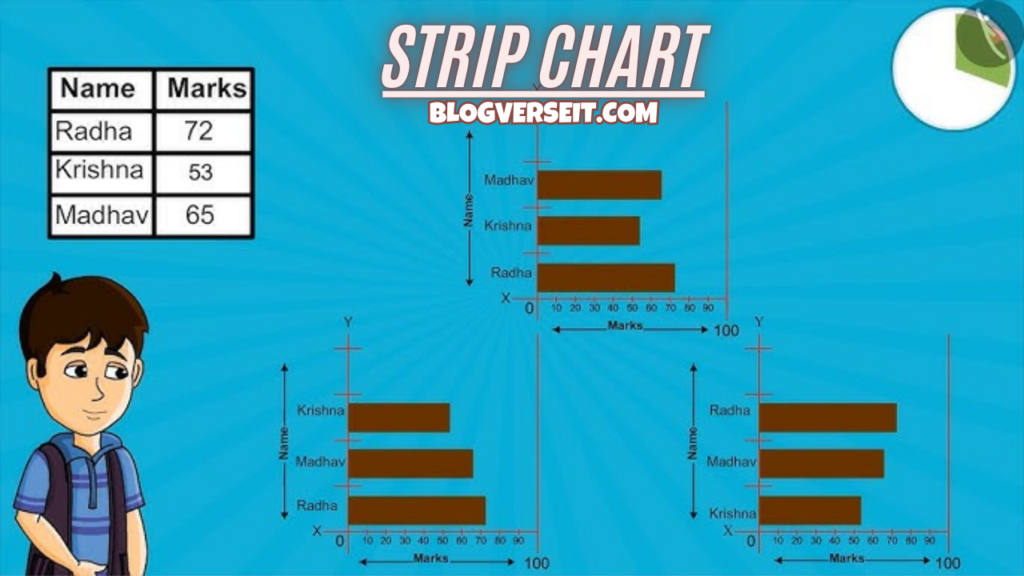Introduction
A strip chart is a graphical representation used to display continuous data over time, typically on a long, narrow piece of paper that moves linearly. This type of chart is often employed in various fields such as engineering and scientific research to monitor and record time-dependent variables, allowing for the visualization of trends and patterns in the data. Strip charts can be created using mechanical or electronic devices known as strip chart recorders, which plot data points in real-time, making them useful for applications that require ongoing tracking of processes like temperature, pressure, or flow rates.
What Is a Strip Chart?
A strip chart, also known as a strip chart recorder, is a device or graphical tool used for continuous data recording. It visualizes real-time information by plotting it on paper or an electronic medium, often on a rolling scroll. The chart displays data over time, typically with one axis representing time and the other axis representing the variable being measured, such as temperature, pressure, or voltage.
The hallmark of the strip chart lies in its ability to show trends in real-time. Unlike static graphs that capture data at a single point, the strip chart offers a dynamic view, allowing users to monitor data changes as they occur. This ability makes it an indispensable tool for anyone who needs to track fluctuations or patterns over time.
The Historical Evolution of Strip Charts
The strip chart traces its origins to the early days of data recording, when mechanical devices first allowed for real-time data visualization. Engineers and scientists sought ways to record continuous data, such as temperature changes or voltage fluctuations. Early strip chart recorders used ink pens that moved over a roll of paper to create a visual representation of the recorded data.
As technology advanced, analog strip charts evolved into digital strip chart recorders, allowing for more precise data collection and analysis. While mechanical versions still exist, digital strip charts have largely replaced them in many industries due to their superior accuracy, ease of use, and ability to store data electronically.
Strip Chart vs. Other Data Visualization Tools
When comparing strip charts to other common data visualization tools like bar graphs, pie charts, and line graphs, their distinct advantage lies in their ability to display continuous, real-time data. Strip charts show how a variable behaves over time, making them ideal for tracking trends that are dynamic and ever-changing.
A line graph, for example, presents a snapshot of data, but it cannot offer the same real-time updates or level of detail that a strip chart provides. Bar graphs and pie charts offer valuable insights but remain unsuitable for time-based data because they don’t convey how a particular measurement evolves.
Key Components of a Strip Chart
Understanding the main components of a strip chart helps one to grasp its functionality better. Whether used mechanically or digitally, every strip chart comprises three essential elements:
Recording Medium:
In traditional strip charts, a roll of paper serves as the recording medium. In modern digital systems, the screen or monitor acts as the display surface for the continuous data stream.
Recording Instrument:
The recording instrument (or stylus in analog models) draws the data points on the chart as the measured variable fluctuates. It continuously adjusts to changes in the monitored parameter.
Time Axis (X-Axis):
This axis always represents time, moving from left to right on the paper or screen. It provides the time reference for the captured data.
Measurement Axis (Y-Axis):
The Y-axis measures the variable under observation, such as temperature, pressure, or another parameter, and represents the scale of these changes.
These components work together seamlessly to offer a complete real-time visual display of data trends.
Types of Strip Chart Recorders
Strip charts come in a variety of formats depending on their specific applications. Understanding these types helps you choose the right tool for your monitoring needs.
Single-Channel Strip Chart Recorder:
This type records data from a single sensor or input. It’s most suitable for straightforward applications where only one parameter needs monitoring, such as tracking temperature in a room.
Multi-Channel Strip Chart Recorder:
When more than one parameter requires monitoring simultaneously, a multi-channel strip chart proves useful. These recorders track several input variables on the same chart, each displayed as a different line or color.
Digital Strip Chart Recorder:
Modern technology has made digital strip chart recorders highly popular. They offer all the benefits of traditional strip charts but with greater precision and the ability to store large amounts of data electronically. This format also supports easy data sharing and archiving.
Each type caters to different industries and tasks, offering flexibility based on the nature of the data being tracked.
Common Applications of Strip Charts
Strip charts serve crucial roles in a wide range of industries, helping professionals maintain oversight of critical processes in real-time. Some of the most common applications include:
Medical Field:
Medical professionals rely on strip charts to monitor vital signs like heart rate and oxygen levels. Electrocardiograms (ECGs) and electroencephalograms (EEGs) use strip charts to display the electrical activity of the heart and brain, respectively.
Manufacturing and Industrial Monitoring:
In industrial settings, strip charts monitor variables like temperature, pressure, and machinery performance. They help ensure optimal operating conditions and detect any deviations that could indicate malfunctions or safety issues.
Environmental Data Monitoring:
Environmental scientists use strip charts to track changes in weather conditions, pollution levels, or other environmental parameters. These charts assist in identifying long-term trends and anomalies in real-time.
Quality Control:
In production facilities, strip charts play a role in quality control by continuously monitoring parameters that affect product quality. For example, tracking temperature or pressure changes during a manufacturing process can prevent defects and ensure consistency.
Strip charts make real-time data accessible in these and many other fields, helping decision-makers respond swiftly to changing conditions.
Advantages of Using Strip Charts
The unique capabilities of strip charts offer a number of advantages over other data visualization tools:
Real-Time Data Monitoring:
The most notable advantage is real-time monitoring. This feature allows users to immediately detect any deviations or trends as they occur, enabling faster response times.
Long-Term Data Recording:
Strip charts provide a continuous record of data over time. This capability proves invaluable for analyzing long-term trends and making informed decisions.
Visual Simplicity:
Strip charts offer a straightforward, easy-to-understand format for visualizing data. Users can quickly identify changes and trends without needing extensive analysis.
Multi-Channel Capability:
Modern strip charts can track multiple variables at once, making them useful in complex systems where multiple parameters need continuous monitoring.
These features make strip charts versatile tools across different industries, offering unparalleled insights into real-time data.
How to Interpret a Strip Chart
Interpreting a strip chart requires attention to both axes: the time (X) axis and the measurement (Y) axis. Here’s a step-by-step guide to reading strip charts effectively:
Identify the Variables:
First, understand the variable being measured on the Y-axis. This could represent temperature, pressure, voltage, or any other parameter.
Assess the Time Frame:
The time intervals on the X-axis allow users to understand the duration of the recorded data. Ensure that you know the start and end times to comprehend how the data has changed over the observation period.
Look for Trends:
Strip charts excel at showing trends. Rising or falling lines indicate changes in the measured variable. Consistent peaks, valleys, or flat lines offer insights into the system’s stability or lack thereof.
Spot Anomalies:
Any sudden shifts in the chart might indicate an anomaly, such as a malfunction, safety issue, or environmental change. The ability to detect these anomalies quickly can save time and resources.
Effective strip chart analysis leads to informed decisions and rapid problem-solving, especially when it comes to industrial monitoring and quality control.
How to Choose the Right Strip Chart Recorder
Selecting the right strip chart recorder depends on your specific needs. Consider these factors:
Number of Channels:
Determine how many variables you need to track. For a single parameter, a single-channel recorder suffices. However, complex systems require a multi-channel recorder for simultaneous monitoring.
Recording Duration:
How long will you need to record data? Long-term monitoring tasks may demand digital recorders with extensive data storage capabilities.
Accuracy and Precision:
Industries like pharmaceuticals, research, and healthcare demand high precision. In these cases, digital strip chart recorders offer superior accuracy compared to their analog counterparts.
Environmental Conditions:
Ensure that the strip chart can withstand your operating environment. Industrial settings, for instance, require rugged devices capable of withstanding harsh conditions.
Choosing the right recorder will ensure optimal performance in your monitoring tasks, whether for medical purposes, industrial oversight, or research.
Tips for Maintaining a Strip Chart Recorder
To ensure that your strip chart recorder performs well over time, follow these maintenance tips:
Clean Regularly:
Keep the device clean, especially in industrial environments where dust or debris can interfere with its operation.
Replace Recording Mediums:
If using an analog strip chart, replace the paper regularly to prevent data loss.
Check Calibration:
Ensure that your recorder remains accurately calibrated to provide correct readings.
Inspect Sensors:
Periodically inspect the sensors that measure your data. Faulty sensors can produce inaccurate data or cause the recorder to malfunction.
Proper maintenance ensures the longevity and accuracy of your strip chart recorder, allowing it to provide reliable data for years to come.
Digital vs. Analog Strip Charts: A Comparison
Digital and analog strip charts each offer distinct advantages, but the choice between the two depends on your needs.
Analog Strip Charts:
These traditional recorders use mechanical pens to draw data on paper. They excel in simplicity and offer a straightforward, visual representation of real-time data. However, they lack the precision, storage, and flexibility of modern digital systems.
Digital Strip Charts:
These devices record data electronically, offering the benefits of precision and storage capacity. With digital recorders, users can store vast amounts of data, perform detailed analyses, and share results easily. Moreover, these recorders eliminate the need for paper, reducing ongoing maintenance.
Most industries today prefer digital strip charts for their accuracy and convenience. However, analog models remain useful in applications where simplicity and visual data representation are paramount.
The Future of Strip Charts in Data Monitoring
As technology advances, the role of strip charts continues to evolve. While traditional analog recorders still have their place, digital strip charts offer new possibilities for data storage, analysis, and sharing. Cloud integration, real-time remote monitoring, and enhanced data visualization capabilities push strip charts into new realms of innovation.
Industries across healthcare, manufacturing, and environmental monitoring will increasingly rely on advanced digital strip charts to provide seamless, accurate, and actionable insights.
Conclusion
Strip charts offer a powerful tool for real-time data visualization and trend analysis across many industries. From their historical roots as analog devices to their modern digital counterparts, strip charts continue to play a pivotal role in fields like healthcare, industrial monitoring, and environmental science. By providing continuous, accurate, and easy-to-interpret data, strip charts remain indispensable for anyone who needs to track and respond to changes in critical parameters.
Also Read: Fsi blog com: A Deep Dive into the Indian Adult Content Website
FAQs
What is the primary purpose of a strip chart?
Strip charts offer continuous, real-time monitoring of data over time, making them ideal for tracking trends and detecting anomalies.
What are the main types of strip chart recorders?
Strip chart recorders come in single-channel and multi-channel formats. Modern versions also include digital strip charts for enhanced accuracy and data storage.
What industries benefit from strip charts?
Healthcare, manufacturing, environmental monitoring, and research all benefit from strip charts for tracking vital parameters in real-time.
How does a digital strip chart differ from an analog one?
Digital strip charts record data electronically and offer greater precision and storage capacity, while analog recorders use mechanical pens to draw data on paper.
What should I consider when choosing a strip chart recorder?
Consider the number of variables to monitor, the recording duration, the required accuracy, and the environmental conditions where the recorder will operate.
How do strip charts help in quality control?
By monitoring key parameters such as temperature or pressure continuously, strip charts help maintain consistent product quality and detect potential issues early.







